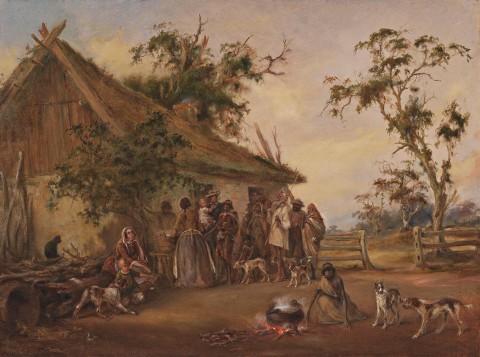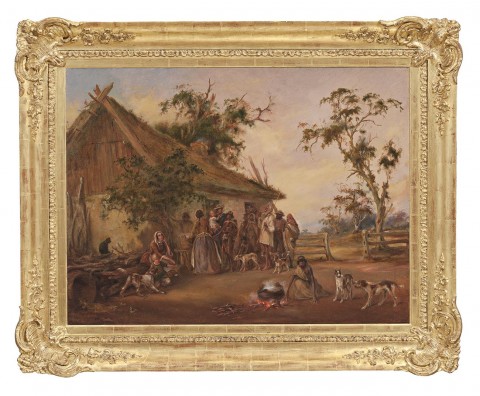BUSH VISITORS, 1859
ALEXANDER SCHRAMM
oil on canvas
68.5 x 91.5 cm
originally signed, dated and inscribed verso: A Schramm / Adelaide / 1859
original frame by David Culley, Adelaide (label attached verso)
Mr Henry Muirhead, Adelaide, acquired in 1859
Thence by descent
Nancy Muirhead, Adelaide
Thence by descent
Private collection, Adelaide
South Australian Art Union Exhibition, Chamber of the House of Assembly, Adelaide, 5 October – 17 October 1859, cat. 70
On long term loan to The Adelaide Club, Adelaide, 1994 – 2018
Catalogue of Pictures and Other Works of Art Collected for Exhibition in the House of Assembly, South Australian Society of Arts, Adelaide, 4 October 1859, cat. 70
‘Exhibition of Works of Art’, The South Australian Advertiser, Adelaide, 5 October 1859, p. 2
‘South Australian Art-Union Exhibition’, The South Australian Register, Adelaide, 5 October 1859, p. 3 (as ‘Blacks at a Cottage Door’)
‘Second Day’, The Adelaide Observer, Adelaide, 8 October 1859, p. 2 (supplement) (as ‘Blacks at a Cottage Door’)
‘South Australian Society of Arts’, The South Australian Register, Adelaide, 18 October 1859, p. 5 (as ‘Blacks at a Cottage Door’)
‘The Society of Arts’, The Adelaide Observer, Adelaide, 22 October 1859, p. 1
‘Society of Arts’, The South Australian Advertiser, Adelaide, 25 October 1859, p. 2 (as ‘South Australian Homestead’)
‘Schramm’s Picture’, The South Australian Advertiser, Adelaide, 28 October 1859, p. 2
‘South Australian Society of Arts’, The Adelaide Observer, Adelaide, 29 October 1859, p. 1 (supplement)
‘South Australia’, The Argus, Melbourne, 29 October 1859, p. 5
‘Schramm’s Picture’, South Australian Weekly Chronicle, Adelaide, 29 October 1859, p. 1
‘South Australian Society of Arts’, The South Australian Register, Adelaide, 29 October 1859, p. 3
‘South Australian Society of Arts’, The South Australian Advertiser, Adelaide, 29 October 1859, p. 3
A scene in South Australia, c.1850, oil on canvas, 41.0 x 47.5 cm, in the collection of the Art Gallery of South Australia, Adelaide
A scene in South Australia, c.1854 – 58, lithograph, 24.9 x 35.7 cm, Penman and Galbraith, Adelaide, in the collection of the National Gallery of Victoria, Melbourne
NGV Schramm.jpg
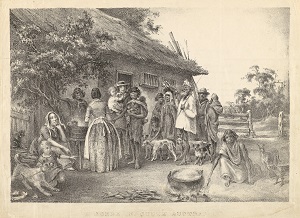
ALEXANDER SCHRAMM
A scene in South Australia,
c.1854 – 1858
lithograph
24.9 x 35.7 cm
courtesy of National Gallery
Victoria, Melbourne
Alexander Schramm is recognised as the most accomplished professional artist active in colonial South Australia and the first to be trained in art beyond Britain. He won a series of prizes at the South Australian Society of Arts exhibitions of the 1850s and 1860s, before his untimely death in November 1864, aged just 50 years. In contrast to his colonial contemporaries though, Schramm produced work in markedly different styles and genres, bringing ‘a sophisticated and wide-ranging background of artistic experience to South Australia’.1 Within barely a decade, Schramm produced finely wrought oil portraits of Adelaide gentry, an outstanding religious painting, a range of small chalk and watercolour drawings of Aboriginal people and colonists which are quite casual in style, the largest oil paintings depicting Aboriginal people and their social life to have been produced in Australia, lithographs of colonial scenes, and even a plaster bust of an Adelaide notable. His work could be sharply defined and filled with light and colour or shadowed and blurred in gloom and melancholy. This great range seems grounded in his artistic training and career in Europe as well his extraordinary intellect, which was sharply critical of colonial realities.
If any single painting by Alexander Schramm serves as an entrée to his Australian career it would be Bush Visitors, painted in 1859, a decade after his arrival in South Australia. This large oil painting has been held in the same family since its original purchase in 1859 by the King William Street watch-maker and jeweller, Henry Muirhead. The painting depicts a group of ten Aboriginal men, women and children (in European clothing, apart from one woman wearing a skin cloak), gathered at the door of a settler’s cottage, importuning the woman of the house while other members of the household observe the situation. What might be interpreted as a straight-forward scene of colonial begging or charity is rendered ambiguous by the friendliness and engagement implicit in the encounter, and by Schramm’s facility in entangling his subjects within a single frame of sociality. The painting is one of Schramm’s larger works and remains in its original frame, fashioned in Adelaide by the city’s first professional framemaker David Culley. On its reverse the painting still bears the original 1859 catalogue number, ‘70’.
AGSA Schramm.jpg
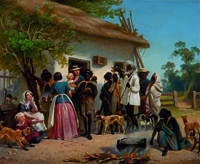
ALEXANDER SCHRAMM
A scene in South Australia, c.1850
oil on canvas
41.0 x 47.5 x 6.5 cm (frame)
courtesy of Art Gallery of South
Australia, Adelaide
Schramm entered Bush Visitors, together with several others, in the section devoted to local artists in the wide-ranging ‘South Australian Art Union Exhibition’ which opened on 4 October 1859 in the Chamber of the House of Assembly on North Terrace. While a newspaper report first noted the painting as No.70, Blacks at a Cottage Door, the exhibition catalogue printed a few days later retitled it as Bush Visitors. The Advertiser reviewer wrote, equivocally enough:
Mr Schramm, an old colonist, has contributed a great number of very spirited oil paintings: in the majority of instances containing groups of aboriginal natives, which have a particularly natural, picturesque, ragged and vagabond appearance. Even the gum trees of Mr Schramm’s pictures wear a scraggy aspect, which is rather an exaggeration than otherwise of the deformities of Australian foliage. Still the pictures have a merit of their own, which any careful observer cannot fail to notice, and the grouping of his natives is both characteristic and successful.2
The exhibition committee initially awarded first prize to James Hazell-Adamson, however following his controversial elimination on the grounds that he was not resident in South Australia, Schramm received first prize for Bush Visitors.
At the age of 35 Schramm travelled to Australia on the Prinzessin Luise, sailing from Hamburg in March 1849 and arriving at Port Adelaide on 7 August. The passenger list has been described as ‘the single most important group of German intellectuals to come to Adelaide’ and included the botanist and Adelaide Botanic Gardens Director, Richard Schomburgk, musicians and composers Gustav Esselbach and Carl Linger, the naturalist Marianne Kreusler, scientists and politicians, as well as the sculptor Emil Todt. After little more than a year Schramm became a naturalised citizen. His first major oil painting in Australia, Adelaide, a tribe of natives on the banks on the River Torrens, was completed in 1850. Now in the collection of the National Gallery of Australia it was originally sold to the Adelaide businessman, C.S. Penny.
By the mid-1850s it seems that Schramm was able to make a living through his art, and Aboriginal subjects (often in combination with Europeans) comprised at least half of his output. Several of these works were lithographs, which Schramm began producing for a wider market from 1854, using the Adelaide printing firm of Penman and Galbraith.3 It seems that these lithographs generally preceded paintings in oil, and this was the case for the lithograph A Scene in South Australia (probably produced between 1854 – 1858), on which this work was based. A smaller painting, closer in detail to the lithograph, A Scene in South Australia, is in the collection of the Art Gallery of South Australia.4
Schramm produced two bodies of work depicting Aboriginal people. The first was characterised by large-scale ambitious paintings that depicted entire encampments comprising up to a hundred figures and the second consisted of simple studies of allegorical encounters between Aboriginal people and Europeans or individual studies of Aboriginal people. Schramm did not attempt any purely ‘ethnographic’ studies in South Australia and instead, his work seems calibrated to the realities of the colonial frontier, assessing and even judging the effects of European contact, even though some of these simpler works strayed close to caricature.
A lithograph of the scene depicted in Bush Visitors was purchased in Adelaide in 1858 by the writer, David Liston, and sent to a friend in England5 with the following inscription which provides fascinating information regarding the scene:
Adelaide Oct 10 1858.
Dear Bob
I met with the annexed Lithograph,
& have sent it to you, the characters are all Portraits, I
know them all & can avouch for its correctness. –
The Scene is a cottage on the North Park Lands, near
the Native Camp, it is Washing Day the Iron Pot, heating
the Water out-side — The Group of Natives, just returning
to Camp, from a days begging in Adelaide, accompanied
by a troop of Dogs — The principal character is "Old King
William". The Woman on his right his Lubra. (i.e. Wife)
the others his family — the whole
[(] Dogs included [)] is true to life.
"Old King William" is well known in Adelaide & is so named
from his resemblance to that Monarch, he came to Town every
morning in a clean White Shirt & carried his spear, his hair
White & gait stately, his Wife has a load on her head,
some of the others at their backs, where
one of the Women carries
her "Piccanini." — the children are
invariably naked, the Men &
Women but scantily clothed, you will notice their Arms & Legs
are very thin & deficient of Muscle, their hands & feet seem
a grade between the Ourang Outang & a perfect human development,
in their rambles they are always accompanied by a large troop of
hungry looking Dogs — the countenance
of the "old King" is a little
too severe — in begging he never takes
less than a silver Sixpence,
if less be offered, it is given to his Lubra or children — I have
endeavoured to fold so as not to injure
the faces, & perhaps you
may take the creases out — We are all well & write in kindest
love & regards to you all & to all old friends;
Yours truly
D. L[iston].
M Robt Hart.; inscribed in pen and brown ink on reverse (vertically)
u.r.: You will notice the Women as well as Men smoke.
This annotation shifts what might otherwise be regarded as a hypothetical, even allegorical scene, into the realm of colonial reality. Despite the reference, the actual site of the image remains difficult to identify although it was probably near the present site of the Adelaide Zoo’s main entrance, adjacent to the parklands. The cottage depicted may well be ‘Park Cottage’, a property owned by the South Australia Company which in 1857, was rented by a G.W.Hawkes. Hawkes had been a book-keeper for the company but by the time Schramm’s lithograph and painting were made he was Secretary of the nearby St Peters Collegiate School. Later secretary of the Art Union of London and South Australia, Hawkes was also a member of the Aborigines Friends Association and it is this, coupled with the friendly attitude shown by the settlers depicted in the painting towards the Aboriginal figures, that points to their identification as Hawkes and his wife.
NGA Schramm.png
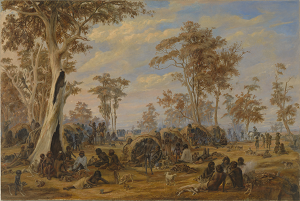
ALEXANDER SCHRAMM
Adelaide, a tribe of natives on the
banks of the River Torrens, 1850
oil on canvas
86.7 x 130.2 cm
courtesy of National Gallery of
Australia, Canberra
For some time the identity of ‘King William’ has been a mystery, however during July 1844 an Aboriginal man known by this name was charged with the attempted murder of a shepherd near Clare and sentenced to imprisonment. It was noted at that time that this man, whose Aboriginal name was Tangko Milaitye, spoke good English.6 Three years later he was released from prison and pardoned so that he might be engaged as a court interpreter – an initiative prompted by an increasing number of court cases involving Aboriginal people from north of Adelaide.7 It appears that he then took up residence in the North Parklands encampment, with his extended family, who became familiar figures to Adelaide townspeople, and subjects for Schramm’s pencil. King William also appeared in several of Schramm’s paintings.
Bush Visitors occupies an important place in Australian art history, marking a fundamental shift in the way in which colonists understood their new land, and their place in it, especially in relation to the Aboriginal people whose dislocation and dispossession Alexander Schramm placed at the very centre of his work. For, while certain critics found Schramm’s works confronting, he was awarded prizes year after year and was patronised by several of the most influential families in South Australia. His art played a crucial role in marking the effects and impact of European colonialism in a colony which placed great store on its capacity to moderate those effects. Importantly, the mirror which Schramm held up to the colonial frontier still retains the capacity to reflect, even today.
1. Hylton, J., South Australia Illustrated. Colonial Painting in the Land of Promise, Art Gallery of South Australia, Adelaide, 2012, p. 126
2. ‘Exhibition of Works of Art’, South Australian Advertiser, Adelaide, 5 October 1859, p. 2
3. Schramm’s simple lithograph of Murray River watercraft at Swan Hill was published in James Allen’s Journal of an experimental trip by the ‘Lady Augusta’ on the River Murray. (1853, Platts, Adelaide). Schramm was not on the voyage but completed the lithograph from a sketch. Schramm may have produced lithographs in Adelaide as early as 1850 (Natives of South Australia, for example), printed by the firm Penman and Galbraith.
4. The Art Gallery of South Australia gives the date for the painting A Scene in South Australia as c.1850, however it is possible that it was produced after both the lithograph and the version currently on offer. See Jones, P., ‘Bush Visitors: Alexander Schramm and his colonial encounters’, unpublished manuscript, Adelaide, 2015, pp. 21 – 22
5. The print is in the collection of the National Gallery of Victoria. This letter is also mentioned in Hylton, op. cit., p. 134. See also Jones, P., ‘A Scene in South Australia by Alexander Schramm and Winter encampments by Eugene von Guérard’, Bunbury, A. (ed.), This Wondrous Land. Colonial Art on Paper, exhibition catalogue, National Gallery of Victoria, Melbourne, 2011, pp. 98 – 99
6. Southern Australian, Adelaide, 5 July 1844, p. 3
7. South Australian Register, Adelaide, 17 March 1847, p. 3
PHILIP JONES
